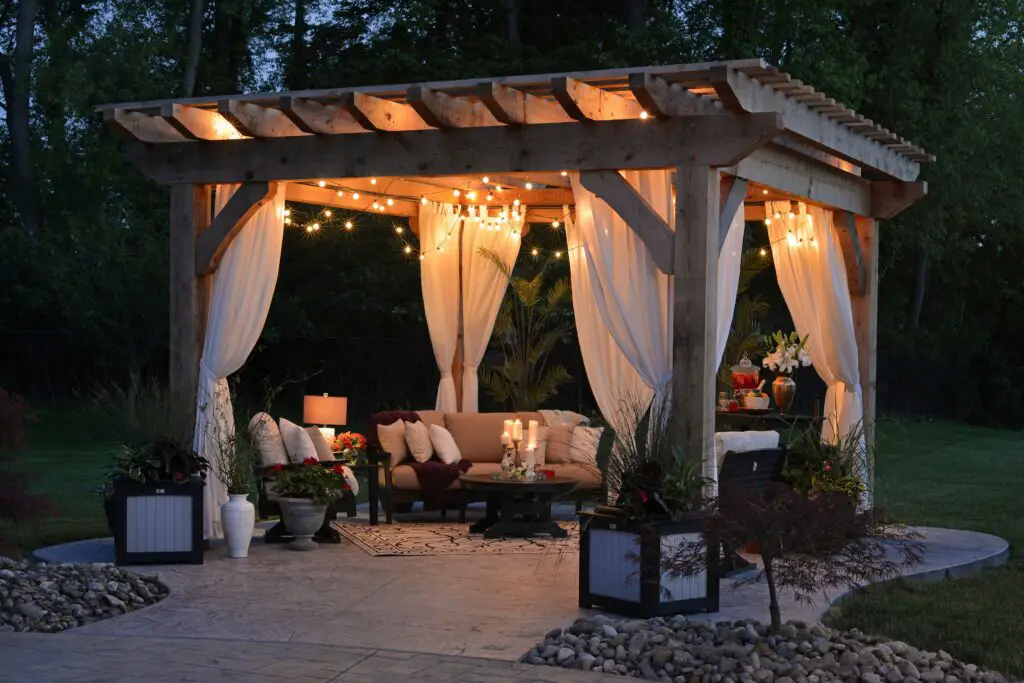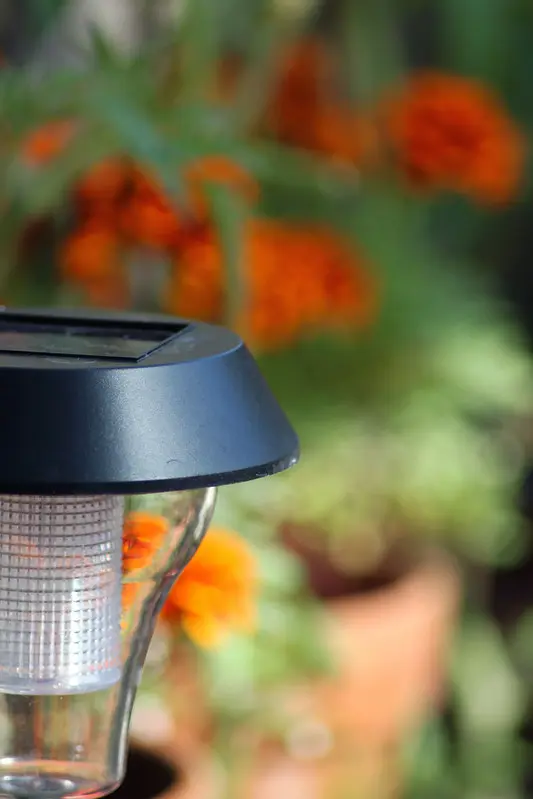People are drawn to solar lights for their ease of installation and environmental friendliness. But there are hundreds of models to choose from and – especially if it’s your first time buying solar lights – there is the question, ‘How to choose solar lights?’
There are five main factors to think through when choosing solar lights.
- Be clear about your purpose
- Durability and weather resistance
- Battery and operating time
- Cost
- Style and aesthetics
Be clear about your purpose
It would be a mistake, for example, to buy the brightest lights you can find if your goal is to create a warm evening ambience for your garden, deck or patio. So begin by clearly identifying your purpose. If you find that you have two or even three different lighting goals, that could be a sign that you need more than one kind of outdoor solar light.
Common purposes for installing solar lights include:
- Solar lights for security
- Solar lights for ambience
- Solar lights for path lighting
- Solar lights for landscape lighting
In the sections that follow, we’ll introduce some of the main features to look for in each type of light.
How to choose a solar security light
There are a variety of features to consider when buying a security light.
Brightness
For a security light, make sure the light gives off at least 300 lumens. This is a little brighter than a 25 watt incandescent bulb and would only be suitable for illuminating a small space such as a doorway or small porch. To light up a larger area, look for security lights with between 700 and 1500 lumens. (Roughly the equivalent of a 60 to 100 watt incandescent bulb.) There are even brighter solar security lights available, but you may want to install two 1500 lumen lights rather than one at 3000 lumens.
It’s also worth checking to see if the light has a switch that allows you to change lighting modes – from low to high for example. You’ll get more hours of life from the battery if it’s in low light mode. For lights that are on a motion sensor this isn’t a big deal, but if you want the light on continuously then the option of a low light mode can be useful, especially during a period of cloudy weather when the battery may not receive a full charge.
Motion sensing or always on?
Pay attention to the motion sensing capability of the light. (Either to make sure the light has motion sensing capability or to avoid paying for it if this isn’t one of your priorities.)
Some motion sensors allow you to adjust the sensitivity: how close must a moving object be before it triggers the motion sensor? This is useful and helps avoid the scenario where your lights turn on every time a car passes by.
How many lamps?
Some units come with more than one lamp, each on a swiveling mount so that you can throw light in different directions. Obviously a plus if you need to light up a large area.
Remote panel
Security lights are often mounted under a roof of some sort where sunlight is not falling directly on the light. If this is your situation, then you’ll want a solar security light with a remote solar panel that can be positioned in direct sunlight. Pay attention to the length of the cord and ensure that it is suitable for your situation.
How to choose solar path lights
Some people are quick to say that you need 100 to 200 lumens for a path, but obviously the length of the path is a key determining factor. Each individual path light will typically provide between 5 and 15 lumens of light. Taken together (these usually come in sets of 8 or more) they will throw enough light on your path to show the way clearly without blinding anyone or distracting from other features of your garden or home.
Also consider the height of the light above ground level. This will be a matter of personal preference and blending with other features of your yard. The stake or body of a path light usually lets the light itself sit anywhere from one to two feet (30 to 60 cm) off the ground.
A common complaint with path lights is the quality of the stake that anchors the light in the ground. If this stake is made of plastic, you’ll want to be very careful not to break it during installation. Consider creating the hole first with steel rebar, a section of pipe or any other suitable items on hand. It will then be easy to secure the path light in the ground without breaking the stake.
How to choose solar lights for ambience

Solar string lights are a popular choice for ambient lighting. Their placement overhead keeps them out of the way, and the hue of the lights tends to be on the warm, yellow side as compared to spot lights or security lights that cast a harsher white light. String lights usually come in a 25 or 50 foot string with the lights spaced about 3 feet apart. The brightness of each individual light is kept relatively low – it’s the combined effect of the lights that bathes your patio or yard in an even, warm light. And as always with solar lights, you don’t have to worry about a wall outlet or guests tripping over a cord.
Pay attention to the capacity of the battery, as indicated by its mAh rating. The higher the mAh rating, the more energy stored in the battery and the longer the lights will stay on. (More on this below.)
How to choose solar lights for landscape lighting
A solar landscape spotlight is a great choice. The brightness of these lights is usually somewhere between 50 and 600 lumens (5 to 45 watts incandescent equivalent). Less bright choices are nice for casting light on small shrubs from below, while the brighter end of the spectrum is perfect for highlighting larger objects such as trees and the home itself.
Durability and weather resistance
Solar lights sit outside under the elements through all kinds of weather, so their ability to stand up to rain is going to be an important determinant of their longevity. Look for lights that advertise IP64, IP65, IP66, IP67 or IP68.
IP64 indicates that the light can handle water splashing against it from any direction. Rain does not fall with high pressure, so IP64 is generally a good indication that the light can handle rainfall.
IP65 or IP66 indicates that the light enclosure can handle a water jet hitting it. IP66 is able to handle a higher pressure jet than IP65, but both are good indicators of a light that can handle rain.
IP67 and IP68 are the next level. Both indicate that the light can handle immersion in water without sustaining damage. IP67 light enclosures can handle immersion of up to 1 meter (a little over 3 feet), while IP68 can handle more than 1 meter.
For more details about IP ratings, you might want to check out this site that discusses IP ratings in more detail.
The battery and operating time
Pay attention to the battery! Assuming that your lights sit in sunlight for most of the day, it is the capacity of the battery that is going to determine how long your solar lights stay on each night.
Battery capacity is indicated by the mAh (milliamp hours) rating of the battery. Higher is better. NiMH and Ni-Cd batteries can be purchased across a wide range of mAh ratings. 600 mAh can be adequate for a small lights such as path, deck and string lights, but is out of the question for more powerful lights such as landscape spotlights and security lights. For these brighter lights, look for a lithium-ion battery with 1200 mAh capacity or more. (Robust lithium-ion batteries can boast mAh ratings of more than 2000.)
NiMH and NiCD batteries come in standard AA and AAA sizes. It is possible to get more hours of operating time from your lights by replacing a lower mAh battery with a higher rated one. But stay within reasonable bounds. If a light ships with a 200 mAh battery, you’ll definitely get longer hours out of it with a 400 mAh replacement. But a 1000 mAh replacement is likely to be overkill (and hence a waste of money) since these larger batteries require larger solar panels and higher voltage (typically 3.7V) to charge fully. This higher voltage is associated with larger solar lights that would never ship with a 200 mAh battery in the first place.
And whatever you do, do not replace rechargeable NiMH or NiCD batteries with regular alkaline batteries. We have written an article about this issue and you can see it here.

Cost
Like anything else, you will get what you pay for. Don’t expect the lowest cost lights to match their more expensive alternatives. Spending a bit more at the start is going to get higher capacity batteries (look for a higher mAh rating and lithium ion batteries if possible) and better build quality.
Style and aesthetics
Last but not least, consider the style and aesthetics of the light. There are so many interesting designs to choose from! Japanese style, torch-like, classic European, modern, multi-colored – there is a huge variety of exciting products to choose from.
Join us for more info about the best solar lights of 2022.

